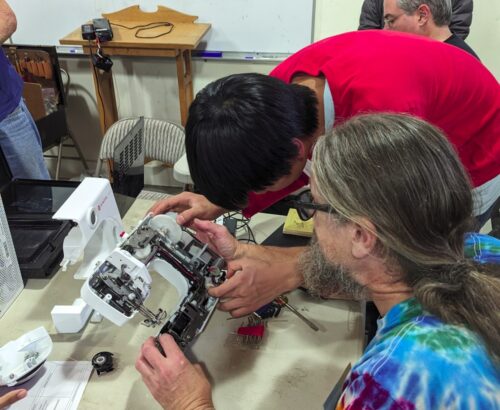This Repair Café took place at the Palo Alto Museum of American Heritage.
The Repair Café is an event in which volunteers (“fixers”) repair peoples’ things for free, usually appliances, clothing, or bicycles, though most anything can be brought if it’s broken. I participated as a fixer and had the opportunity to repair some interesting things.
There was a broken IR remote that was the only way to control a Bose radio and CD player. In my opinion, based on trying to fix the thing, this was a very poorly designed product: not only were there no buttons on the radio itself, but the remote was of very cheap quality — the type that consists of a sheet of thin plastic (rather than rubber like most remotes) with raised bumps and conductive material that you press down onto some contacts to bridge them (they are commonly used in electronics projects). In fact, this was the second remote that the client had purchased. After cleaning the remote and testing some parts (battery contacts, capacitor, IR LED) with a multimeter, I was unable to find the problem.
In addition, someone brought in a Singer M1000 sewing machine whose shuttle hook and feed-dog were out of time with the needle, which I worked on with someone more experienced in sewing machines. The hook and feed-dog were connected to the same shaft, which was driven by a bevel gear. The feed-dog gear was attatched directly to the shaft and not movable. First, to get the feed-dog in time, we had to loosen the collar and slide the bevel gear back, disengaging the common shaft from the needle, and turn it a few teeth, then re-engage it until the needle and feed-dog were in time (the feed dog should be below the needle plate when the needle enters the fabric). Then, to time the hook, we had to repeat a similar process, removing the entire hook assembly and rotating it slightly before reinserting it (this process was far more trial-and-error based; we reinserted it and inserted it a number of times before it was finally in time.)

Of course, those weren’t the only things, nor even the only interesting things (someone brought some binoculars whose images didn’t converge), but I’m only going to write about these two cases because I have the most to say about their repairs.
By the way, here’s a short review of what you get for the $80 Singer M1000 based upon my very narrow experience with sewing machines:
- The only means of controlling the stitch is through the stitch selection dial, which gives straight stitches with more-or-less continuous length adjustment as well as a few zig-zag stitches of predetermined width and length. It also has two or three other fancier stitches whose names I do not know, also preset width and length.
- The foot pedal is single-speed. It is either on or off, unlike other models where you can vary the speed by pressing down more.
- The motor is a DC motor, powered by a small “wall-wart” power supply.
- There is no means of disconnecting the needle and shuttle from the motor when winding bobbins
- The bobbin is loaded from the top and the bobbin case basically “floats” inside the shuttle hook. As far as I saw, the only thing that holds the bobbin case in place is the needle plate.
- Lighting is provided by a single THT LED. That came as a bit of a surprise after seeing the large incandescent lightbulbs of earlier machines.
- Most of the gears were plastic and were keyed directly to the shaft as mentioned before rather than using a grub screw to allow for easier, more continuous adjustments. I assume the sewing machine came from the factory in time but the gears somehow slipped out of time.
- Actually, most of the entire sewing machine is plastic. For example, the shuttle hook is plastic with a metal insert to grab the thread.
- It’s really small and portable, but also not so convenient to use
EDIT: The M1000 is a “mending machine”, designed to be affordable and good at mending clothes rather than professional sewing. So I suppose that explains why it has fewer features and is somewhat more cheaply built.

